It has been said that nothing lasts forever. While the concept is true, when we frame our lives we look for foundations to build on that are long-lasting, and prayerfully will last even longer still. We don’t build with the intention that it is short-lived! True, there is scaffolding that is constructed to hold the works of building, and eventually they come down, but the reality is that we hope what we build has a longevity that surpasses our own lives.
But, as you look over the past few millennia, one can see that everything we have built has eventually crumbled. Shore it up, rebuild broken pieces, and still everything we see is simply crumbling, although it may still be standing in the same place.
Ruins. Archaeologists, like every other category of science, look to the ancient ruins to determine what life was like, you know, “…back then…”. Science even looks to places we have never been to determine the building blocks of the earth, the solar system, even the entire universe. They use equipment with names like Hubble, probes, the International Space Station and a host of other methods to determine the structure and makeup of the worlds beyond us, hoping to shed light on our own creation.
As close as our own backyard, it is a mighty struggle to determine where our Moon came from. It’s makeup does not fit the wild theories some have. But the search continues to understand.
So, let’s bring all those gazillion miles back home to something as close as the nose on your face. Go ahead… glance down… You can see the tip of your nose, right?
Smaller than the naked eye can see are those phenomenal building blocks of life that are the foundation of everything we experience on a daily basis. We use words like cells, molecules, electrons, protons, nucleus, and even DNA, to describe the components that make up everything, whether living or not.
Everything that makes up everything is smaller than what could be visible with the naked eye, or even a simple microscope. How small does this foundation go?
Everything that makes up everything is smaller than what could be visible with the naked eye, or even a simple microscope. How small does this foundation go? Click To TweetWe build more intricate tools and depend on huge mathematical equations and computers to dig deeper and deeper.
The deeper we go, the bigger the price tag for the equipment required.
The deeper we go, the more we find! I suspect that the microscopic world has no beginning that we will ever comprehend in my lifetime.
Everything is made up of something even smaller!
Remember the story by Isaac Asimov? Fantastic Voyage. To fight an inoperable problem in a body, a crew is shrunk to the size of a red blood cell and injected into the patient to repair the problem from within. In their miniaturized size, you can see what we cannot see with our naked eye, and it is now monstrously dangerous! The imagination of this story is fascinating!
It makes one wonder… If we keep digging deeper will we continue to find the same kind of results, you know, an even smaller foundational block that we need fancier equipment to understand? And, will it really matter?
Geneticists look to modify our DNA to build a better result – whether our food supply, or our own bodies, we keep changing that which we don’t truly understand.
Our planet shakes itself every so often, actually thousands of times per day, and we simply the vibrations earthquakes. The existence of our life rattles around, foundations crack and fail, buildings topple, tsunamis, floods, slides, and many suffer from a calamity.
This brings me to a thought for my day. Everything that can be shaken, will be shaken! Prophets of old forecasted the future of earth as broken, dissolved and moved. (Isaiah 24:19) Jesus describes the time when even the “…powers of the heavens will be shaken…” (Matthew 24:29, Mark 13:25, Luke 21:26). If our foundation can be shaken, the day will come when it will undergo that very test. Will it survive?
This destruction can be viewed as natural or spiritual. Apply it close, or far away. Today, or even tomorrow. This century, or the next. Compare our present structure to others, today, or somewhere in the past. Ask yourself this question: Have we sufficiently built so we may continue to last? Or will everything eventually crumble and fall? Dystopia. Ruins.
How quickly will this happen?
There is a Doomsday Clock that was created shortly after WWII by the various scientists that worked on the Manhattan Project, the code name used in creating the atomic bomb. It resides in Chicago. The newsletter/bulletin that publishes how close we are to a global disaster, deals not only with nuclear fears but has also included a focus on “new developments in the life sciences and technology that could inflict irrevocable harm to humanity“, including climate change.
The Bulletin’s clock is not a gauge to register the ups and downs of the international power struggle; it is intended to reflect basic changes in the level of continuous danger in which mankind lives in the nuclear age…Click Here
From a spiritual application, we continue to look forward to that redemption from the destruction that Jesus spoke of two thousand years ago. After describing the times, he simply states:
Now when these things begin to happen,
look up and lift up your heads,
because your redemption draws near.
(Luke 21:28 NKJV)
Since the turn of the century, and having lived through nearly half of the previous century, I find myself more constantly aware of our present age. We struggle with the changes that are happening, and we see cracks in the fabric of life all around us, not only in the war zone but also in the more peaceful areas. Life is not improving, progressing, rather, it appears that life is fracturing. We peer into others lives and see their problems, but are often blind to our own situation. Deeper we dig into the unsustainable not realizing the weakening of the structure.
How can we not see the picture of where we are? Blind? Close to the end? Perhaps. But we are definitely moving closer and closer to the darkness!
The Apostle Paul picks up the theme of Jesus as he warns the church that the Lord returns as a thief under the cover of night. Redemption!
But concerning the times and the seasons, brethren, you have no need that I should write to you. For you yourselves know perfectly that the day of the Lord so comes as a thief in the night. For when they say, “Peace and safety!” then sudden destruction comes upon them, as labor pains upon a pregnant woman. And they shall not escape. But you, brethren, are not in darkness, so that this Day should overtake you as a thief. You are all sons of light and sons of the day. We are not of the night nor of darkness. Therefore let us not sleep, as others do, but let us watch and be sober. For those who sleep, sleep at night, and those who get drunk are drunk at night. But let us who are of the day be sober, putting on the breastplate of faith and love, and as a helmet the hope of salvation.
(1 Thessalonians 5:1-8 NKJV)“
“But you are not in darkness…” are words of hope, as well as admonishment. Hope that we can see the time is getting close and our understanding kicks in to ensure our feet are firmly planted on the Rock and our salvation is secure, while at the same time we reach out to our loved ones, and strangers around the world striving to bring more to a place of safety. All the while, we admonish ourselves to not get so caught up in the times so that we lose sight of our final destination.
Perhaps this is the message someone needs to hear today.
Do not lose sight of your hope. Keep your eyes fixed ahead. Shaking will come. The fabric will tear, fractures will occur, and the foundation will start to crumble. All is not lost! You can be prepared!

